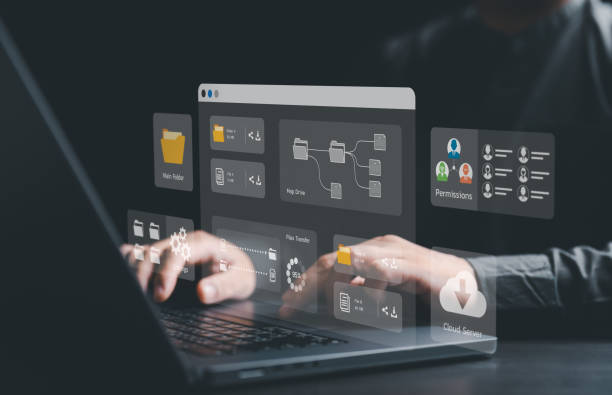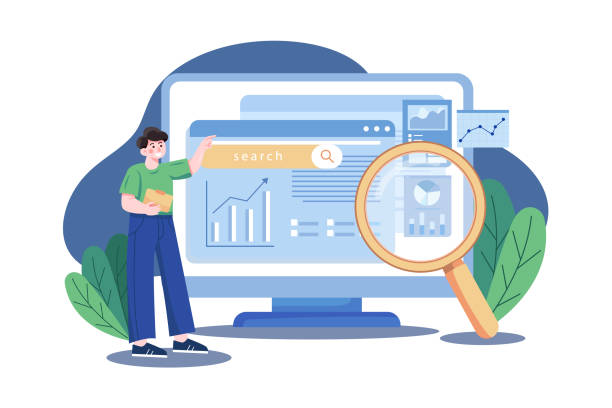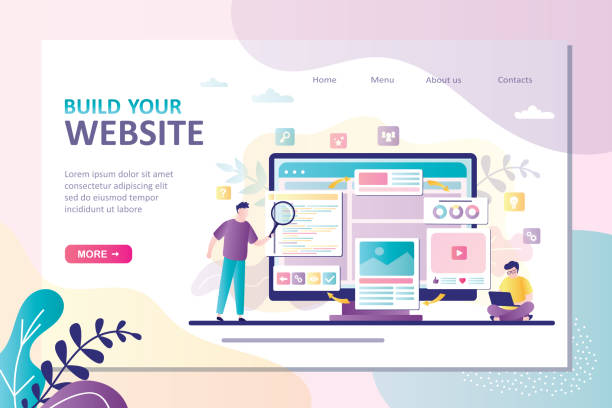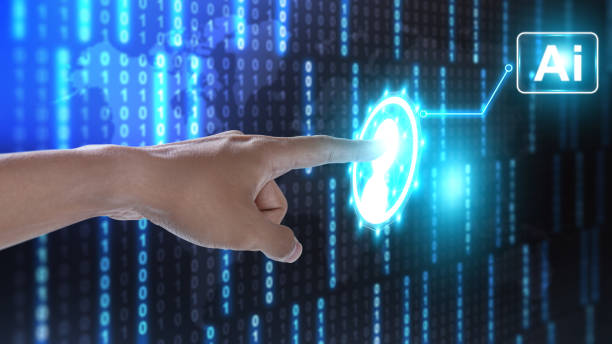Introduction to Modern UI Web Design: Why it Matters?

In today’s digital world, the first thing a user encounters when visiting a website is its user interface.
A modern and attractive #user_interface is not only visually appealing but also directly impacts #user_experience and ultimately the success of an online business.
Modern UI web design is no longer a luxury, but a necessity.
This approach focuses on creating websites that are not only beautiful but also easy, intuitive, and enjoyable to use.
This section is an explanation and will help you gain a deeper understanding of the nature and importance of this type of design.
At the heart of this concept lies an understanding of user needs and expectations.
Modern design, beyond mere aesthetics, seeks to solve user problems and provide efficient solutions.
From #responsiveness for correct display on all devices to high loading speed and smooth navigation, every detail in modern UI web design is carefully considered.
This approach transforms the website into a powerful tool for attracting and retaining customers, playing a crucial role in establishing a successful online presence.
An old and inefficient user interface can quickly drive visitors away, while a modern and intelligent one can captivate and retain them.
This article analytically and instructively examines various aspects of modern web design to familiarize you with the challenges and opportunities in this field.
Falling behind in competition with large online stores?
Rasaweb, with professional e-commerce website design, brings your business online and increases your market share!
✅ Enhance brand credibility and customer trust
✅ Easy shopping experience leads to more sales
⚡ Act now for a free website design consultation!
Key Principles in Modern UI/UX Design

To achieve modern UI web design, a set of fundamental principles must be adhered to.
These principles form the backbone of any successful design project, ensuring that the final product is both functional and visually appealing.
The first and most important principle is user-centricity.
Every decision, from choosing fonts and colors to element layout, must be made with the end-user experience in mind.
The website should prioritize user needs and goals.
The second principle is simplicity and minimalism.
Modern user interfaces avoid clutter and complexity, striving to convey maximum information with minimal elements.
This helps the user achieve their goal without confusion.
The third principle is responsiveness.
Given the variety of smart devices, a modern website must automatically adjust to different screen sizes to provide a seamless user experience across mobile, tablet, and desktop.
This specialized section highlights the importance of modern graphical user interface.
The fourth principle is accessibility.
A modern website should be accessible to all individuals, including those with disabilities.
This includes using appropriate color contrast, alt tags for images, and keyboard navigation.
Modern UI web design also emphasizes interactivity.
Elements should be intuitive and provide appropriate feedback to user actions.
An interactive website encourages users to engage more with the content and provides an enjoyable experience for them.
Advanced Tools and Technologies in Modern Web Design

To implement a modern UI web design, familiarity and mastery of a set of advanced tools and technologies are required.
The world of web design is rapidly changing, and designers must always stay updated with the latest trends and development tools.
Key tools for UI/UX design include Figma, Sketch, and Adobe XD, which efficiently enable design, prototyping, and team collaboration.
These tools simplify interactive user interface design and wireframing.
In front-end development, HTML5 and CSS3 are the foundation of any website, but for creating complex and dynamic interactions, JavaScript and frameworks like React, Angular, and Vue.js play a crucial role.
These frameworks allow developers to create reusable components and accelerate the development process.
For managing styles and responsive design, using CSS preprocessors like SASS or LESS and CSS frameworks like Tailwind CSS or Bootstrap is very common.
Modern UI web design also relies on version control tools like Git and platforms like GitHub for code management and team collaboration.
Understanding these tools is essential for any modern web designer, and this section provides a specialized and guiding introduction to them.
This table shows the key tools for designing and developing a modern website:
| Category | Tool/Technology | Main Use |
|---|---|---|
| UI/UX Design | Figma, Sketch, Adobe XD | User interface design, prototyping, wireframing |
| Front-end Development | React, Angular, Vue.js | Building interactive UIs, SPA development |
| CSS Styling | SASS, LESS, Tailwind CSS, Bootstrap | Style management, responsive design |
| Version Control | Git, GitHub | Version control, team collaboration |
The Importance of User Research and Prototyping in Modern Design

Before any visual design initiative, modern UI web design strongly emphasizes user research.
A deep understanding of user needs, behaviors, and pain points is the foundation for building a successful product.
This stage includes techniques such as user interviews, surveys, creating user personas, and competitor analysis.
The goal is to ensure that the final product truly solves a problem and creates value for users before spending significant time and resources on development.
Data obtained from user research helps designers make more informed decisions and avoid guesswork.
This section is educational and analytical, delving into the research process.
After user research, the prototyping stage begins.
Prototyping allows designers to test their ideas early and at low cost.
From simple, initial wireframes to high-fidelity prototypes that are close to the final product, this process helps iterate and refine the design.
Obtaining feedback from users in the early prototyping stages allows for identifying and resolving potential issues before full implementation.
This iterative approach reduces project risks and optimizes development time and cost.
Modern UI web design without these initial stages may result in a product that does not meet actual user needs and ultimately fails.
The prototyping process helps designers challenge their ideas and find the best solution for an optimal user experience.
Are you tired of your company’s website not getting the recognition it deserves and losing potential customers? Solve this problem permanently with professional and effective website design by Rasaweb!
✅ Enhance brand credibility and attract customers
✅ Generate targeted sales leads
⚡ Contact us now for a free consultation!
Visual and Aesthetic Trends in Modern Web Design

The world of modern UI web design is constantly evolving, and visual and aesthetic trends play a significant role in capturing user attention.
While functionality and usability are paramount, an attractive appearance cannot be overlooked.
Trends like minimalism, which emphasize whitespace and essential elements, remain popular.
But alongside it, we are also witnessing the emergence of newer trends.
Dark Mode, which provides a more comfortable viewing experience in low-light environments, has become a standard feature in modern websites.
This entertaining and analytical section explores these trends.
The trend towards using 3D graphics and subtle animations to add depth and dynamism to the user interface is also growing.
Large and bold typographies for headings, and the use of bright colors and vibrant gradients to create a sense of modernity and visual appeal, are other features of modern UI web design.
Glassmorphism and Neumorphism are also new design styles that give elements a distinct and profound look with glass effects and special shading.
These trends not only enhance the site’s aesthetics but can also help guide the user’s eye and improve navigation.
The correct selection of visual trends for a specific project requires a deep understanding of the brand and target audience, so that the website’s appearance is aligned with its functionality.
Optimizing User Experience and Accessibility in Modern Websites

Modern UI web design is not limited to visual aesthetics; optimizing user experience (UX) and ensuring accessibility for all users are its main pillars.
A website might be visually stunning, but if users cannot easily interact with it or if it’s not usable for individuals with disabilities, it will ultimately fail.
UX optimization includes factors such as high loading speed, intuitive and easy navigation, simple and user-friendly forms, and providing appropriate feedback to user actions.
This section is guiding and explanatory.
Accessibility is a crucial aspect of modern UI web design that is often overlooked.
This means designing a website that is usable for all individuals, including users with visual, auditory, motor, or cognitive impairments.
Implementing WCAG (Web Content Accessibility Guidelines) principles includes items such as appropriate color contrast for text and background, using descriptive alt tags for images, full keyboard navigation, and providing captions for video content.
Web accessibility is not only an ethical and legal requirement but can also expand your target market and improve your brand reputation.
By adhering to these principles, you can ensure that your website is not only beautiful and efficient but also usable for a wider range of audiences.
Performance and Speed Optimization in Modern Web Design

In an era where speed is paramount, website performance and loading speed optimization are among the most critical aspects of modern UI web design.
Today’s users are impatient and expect websites to load in a fraction of a second.
Even a small delay can lead to user loss and a decrease in conversion rates.
Speed optimization does not only depend on the server or the user’s internet; a significant part of it relates to optimized coding, proper use of images and media files, and front-end resource optimization.
This section is specialized and analytical.
There are numerous methods to improve speed.
Compressing images without losing quality, using next-generation image formats like WebP, optimizing CSS and JavaScript code by removing superfluous code (minification), and GZIP compression are among these methods.
Using a CDN (Content Delivery Network) to deliver content from the nearest server to the user significantly increases loading speed.
Also, lazy loading for images and videos that are not in the initial viewport helps ensure that only necessary content is loaded first.
Modern UI web design should consider these factors from the outset to provide the best possible user experience.
This table shows some optimization criteria and methods:
| Criterion/Method | Description | Impact on Speed |
|---|---|---|
| LCP (Largest Contentful Paint) | Time to load the largest visual element in the viewport | Most important criterion for user loading experience, should be under 2.5 seconds |
| FID (First Input Delay) | Delay between the user’s first interaction and the browser’s response | Important for interactivity, should be under 100 milliseconds |
| CLS (Cumulative Layout Shift) | Amount of unexpected layout shifts | Impacts visual experience, should be below 0.1 |
| Image Compression | Reducing image file sizes without quality loss | Significant reduction in loading time |
| CDN (Content Delivery Network) | Delivering content from the nearest server to the user | Reduces server response time and loads faster |
The Future of UI/UX Design on the Web

Modern UI web design is constantly evolving and has a future full of innovation ahead.
Technologies such as Artificial Intelligence (AI), Virtual Reality (VR), and Augmented Reality (AR) are set to play a more prominent role in how we interact with websites.
AI can help personalize the user experience on a large scale, from suggesting relevant content to intelligent chatbots that provide 24/7 support.
This section contains thought-provoking and news-related content.
Virtual Reality and Augmented Reality also have great potential for creating immersive and interactive web experiences, especially in areas like e-commerce (e.g., virtual try-on for clothes) and education.
Web design with voice and gesture control is also advancing, allowing users to interact with websites without needing a keyboard and mouse.
These trends indicate that modern UI web design is moving towards creating seamless, personalized, and multi-sensory experiences.
The main challenge for future designers is not only confronting these new technologies but integrating them in a way that genuinely leads to improved user experience and is not merely a flashy feature.
These advancements open up new horizons for web design.
Did you know that customers’ first impression of your company is your website? Multiply your business’s credibility with a powerful corporate website from Rasaweb!
✅ Custom and eye-catching design tailored to your brand
✅ Improved user experience and increased customer attraction
⚡ Get a free consultation now!
Common Mistakes in Modern Design and Ways to Avoid Them

Despite all tips and guidelines, there are common mistakes in modern UI web design that can jeopardize user experience and lead to project failure.
One such mistake is neglecting user testing.
Designing based on assumptions without validation from real users can lead to a product that does not meet the audience’s needs.
The solution is to conduct user tests at various stages of the design and development process, especially with target groups.
This section is educational and guiding.
Another mistake is information overload and a cluttered user interface.
In an attempt to provide all information or features, designers sometimes overcrowd the user interface, leading to user confusion.
A minimalist approach and the use of whitespace, along with clear and hierarchical navigation, can solve this problem.
Neglecting responsiveness is also a major error, as a significant portion of users access websites via mobile devices.
Lack of optimization for loading speed, as previously mentioned, can also severely impact user experience.
Modern UI web design requires attention to detail and continuous iteration.
To avoid these mistakes, designers must always listen to feedback, adhere to user-centered design principles, and stay familiar with the latest technologies and trends to deliver an efficient and attractive website.
Successful Case Studies of Modern UI Web Design

To gain a deeper understanding of how to successfully implement modern UI web design, examining case studies from leading companies can be very insightful.
Companies like Airbnb, Spotify, and Google are prime examples of websites that are constantly innovating their user interface and user experience.
Airbnb, with its intuitive navigation and simple booking process, provides a seamless user experience for travelers and hosts.
Its design is very clean, with high-quality images and ample whitespace, allowing the user to easily find the information they need.
This section is news and analytical.
Spotify, with its minimal design and focus on content, offers an enjoyable listening experience.
Its user interface is intuitive, and features like personalized recommendations and customizable playlists have made it a prominent example in user interface design.
These companies are not only leaders in aesthetics but also optimize their user experience through continuous user research and testing.
This approach allows them to anticipate evolving user needs and deliver products that users truly love.
A close examination of these examples can be a great inspiration for anyone looking to undertake modern UI web design.
The lessons learned from these successes can be valuable guidance for future projects.
Frequently Asked Questions
| No. | Question | Answer |
|---|---|---|
| 1 | What does modern user interface mean in website design? | It means designing a website that has a beautiful, attractive, and up-to-date appearance, while being easy, intuitive, and enjoyable for the user to use (emphasis on UX/UI). |
| 2 | What are the main features of a modern user interface? | Includes minimal design, ample whitespace, attractive typography, a harmonious color palette, high-quality images and icons, full responsiveness, high loading speed, and appropriate use of animations and micro-interactions. |
| 3 | Why is a modern user interface important for a website? | It improves user experience, increases visitor trust, reduces bounce rate, increases user time on site, strengthens brand, and ultimately helps achieve business goals (such as sales or user acquisition). |
| 4 | What is the role of responsiveness in modern user interfaces? | Responsiveness is a critical component; a modern UI website must display correctly and perform optimally on all devices (mobile, tablet, desktop). |
| 5 | How does typography (font selection) affect modern user interfaces? | Appropriate typography increases readability, defines information hierarchy, and plays a significant role in creating a modern visual feel that aligns with brand identity. |
| 6 | What is the importance of using whitespace in modern design? | Whitespace allows visual elements to “breathe,” prevents clutter, focuses user attention on main content, and creates a clean and professional appearance. |
| 7 | What role do micro-interactions play in improving modern user interfaces? | Micro-interactions (such as a button changing color on click, displaying a form confirmation message) provide visual feedback to the user, make site usage more interactive and enjoyable, and convey a sense of attention to detail. |
| 8 | What tools are used for modern user interface design? | Common tools include Figma, Sketch, Adobe XD, and also prototyping tools. |
| 9 | How can one ensure that a modern user interface is also user-friendly (usable)? | Through user testing, receiving feedback from real users, adhering to accessibility principles, and intuitive navigation. |
| 10 | Does modern design mean removing all graphical elements? | No, modernity means intelligent and purposeful use of graphic elements, colors, images, and animations to create an attractive yet functional experience, not their unnecessary removal. |
And other advertising services by Rasaweb Advertising Agency:
- Smart Sales Automation: A blend of creativity and technology to improve SEO ranking through SEO-driven content strategy.
- Smart Digital Branding: A professional solution for analyzing customer behavior, focusing on SEO-driven content strategy.
- Smart Link Building: A professional solution for increasing sales by focusing on precise audience targeting.
- Smart Marketplace: An innovative platform for improving campaign management with intelligent data analysis.
- Smart UI/UX: Transform sales by optimizing key pages.
And hundreds of other services in internet advertising, advertising consultation, and organizational solutions.
Internet Advertising | Advertising Strategy | Advertorial
Sources
Importance of UI and UX Design in Websites
Website Design Training with HTML, CSS, and JavaScript
What is UI and UX?
UI and UX Design Rules in Websites
? To elevate your business in the digital world and achieve peak success, Rasaweb Afarin Digital Marketing Agency is always by your side, offering services such as custom website design, SEO, and content marketing.
📍 Tehran, Mirdamad Street, next to Bank Markazi, Kazerun Jonubi Alley, Ramin Alley, No. 6


